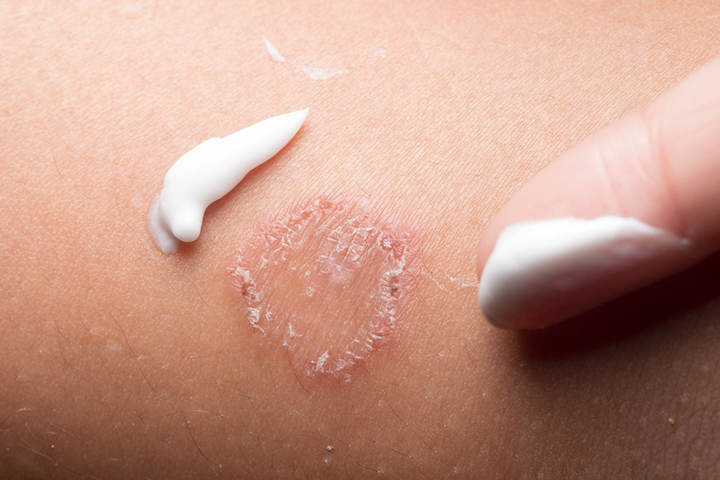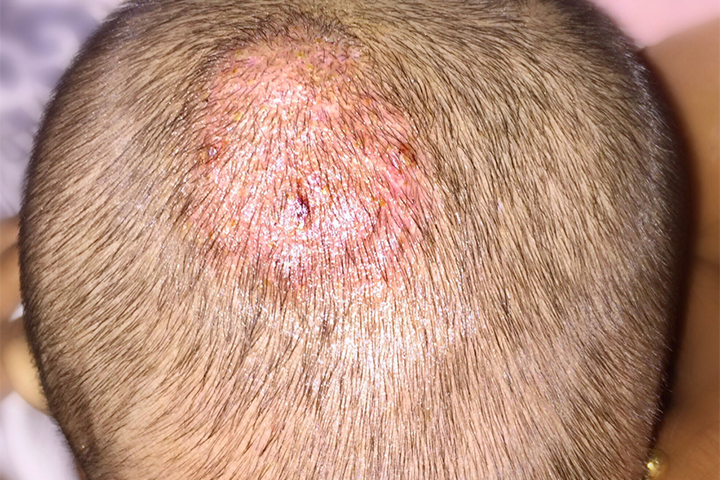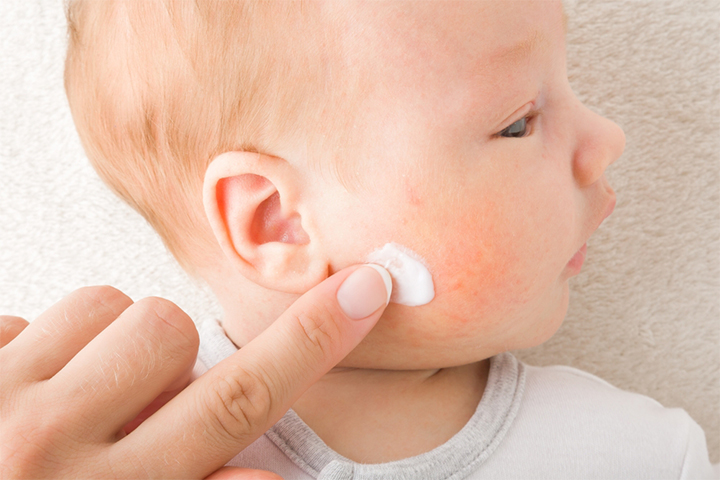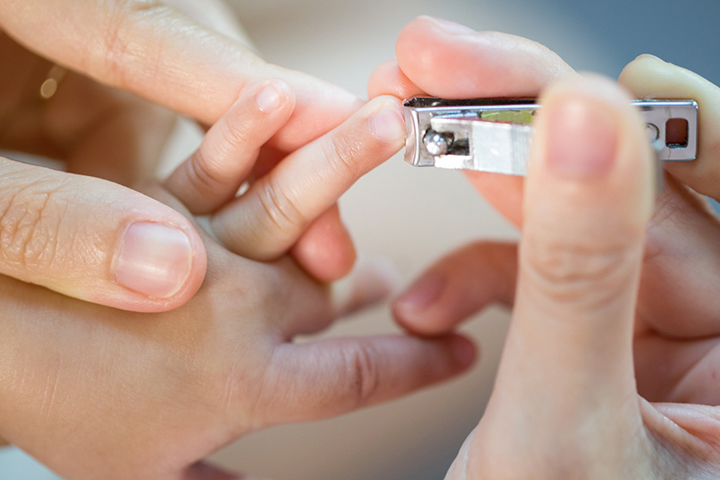Ringworm in babies is a common contagious disease (1). Contrary to what the name may suggest, ringworm originates because of fungal infection and not worms. The condition often manifests on one side of the body or face and looks like a round, scaly, pink, or red patch (2). This patch is usually itchy but rarely painful. In most cases, a cut or eczema on the skin may lead to the occurrence of ringworm. The condition may spread through an infected person or pet. Therefore, maintaining hygiene in babies is the most important step toward preventing infection. This post provides you with information on the causes and symptoms of ringworm in babies and helps you understand its treatment options and preventive measures. Read on.
What Is Ringworm?
Ringworm or dermatophytosis is an infection caused by different species of fungi. Dermatophytes of the genera TrichophytoniXA genus of fungi in the order of Onygenales that infects humans and other animals’ skin, hair, and nails. and MicrosporumiXA genus of fungi that is the causative agent of ringworm, tinea corporis, tinea capitis, and other fungal skin infections.are the most common causative agents. Tinea is the medical name for dermatophyteiXFungi that affect the skin, hair, and nails superficially and require keratin to grow. infections (3). Fungal skin infections such as athlete’s foot, jock itch, and ringworms are often collectively known as Tinea.
The superficial fungal infection or dermatophytosis of the arms, legs, and glabrous skin is called Tinea Corporis. If it occurs on the scalp, it is called Tinea Capitis. When it affects the feet, including toes, it is called tinea pedis. When it infects finger nails or toe nails, it is called tinea unguium.(4).
Signs And Symptoms Of Ringworm Infection
Ringworm starts as scaly, red patches on the skin and grows into rings. As the infection grows, the rings get larger from a few millimeters to a few centimeters in diameter. However, ringworm may not always appear in a ring shape. They also stop growing once they are about one inch long (5).
The rings are scaly or crusty on the outside and smooth in the middle. The infected area could be itchy, and cause irritation but not dangerous or painful. Your baby might have one or several patches depending upon the intensity of the infection. Also, the origination of patches might be generalized and may affect different body parts.
If you notice changes in your baby’s nails, such as a change in color or discoloration, thickening, or brittle nails, it could be a sign of ringworm infection (onychomycosis). Ringworm can affect one or more nails on the hands or feet. A nail infection in babies is not usually a direct sign of ringworm, as ringworm is a fungus that impacts the skin rather than the nails. However, fungal infections can appear in a variety of ways. Hence, prompt consultation with a healthcare professional is vital for accurate diagnosis and timely treatment initiation (6).
Which Body Parts Are Affected?
The infection usually affects the scalp and other body parts, including the tummy wall stomach, thighs, back, arms, chest and sometimes the face. It can also affect feet, toes and nails.
The scalp ringworm can become a kerion, a swollen lesion with moisture, which often appears over the area where the initial ringworm infection occurred (7). It is an inflammation resulting from the fungus. The rings have pustules or pimple-like bumps, which gradually subside as the treatment begins.
But before beginning any treatment, identification of the cause is crucial.
Could not load the poll.
What Causes Ringworm In Babies?
Ringworm is caused by a fungus and is highly contagious, spreading through fungal spores and physical contact. From the age of two months, babies could start taking their hands in their mouth (8). Once they start to crawl and move around, they explore more and could become more vulnerable to infections as they put objects such as toys and such in the mouth. Considering that, here are a few causes of ringworm in babies (2):
1. Skin-to-skin contact:
Your baby might get infected by direct skin-to-skin contact with a person infected with ringworm. It can occur when your baby holds the hands of an infected person who has touched or scratched their rash.
2. Broken skin:
A cut, eczema patch, or scratch paves the way for the infection to enter the body. The fungus can get in if the baby comes in contact with infected sheets, toys, towels, clothes, or just while crawling in a park or a garden.
3. Shared things:
Ringworm on the baby’s scalp occurs when the baby uses an infected person’s objects such as the hairbrush, towels, bedclothes, caps, or hats.
4. Through pets:
Kittens and puppies can transfer ringworm to humans. If the baby comes in direct or indirect contact with an infected pet, the risk increases.
In addition to the above reasons, certain factors increase the possibility of ringworm in babies (9):
- Warm climate (where tinea thrives)
- MalnourishmentiXLack of proper nutrition that is necessary for the body to function.
- Babies with a weak immune system
- Genetics; some experts believe that a few babies have a genetic tendency to get infected.
- Excessive sweating could increase the chance of getting ringworm as the fungus thrives in a humid climate.
- Continuous use of enclosed footwear like tennis shoes and wet socks, poor hygiene, minor skin or nail injuries increase the risk.
Ringworm on the scalp may be confused for cradle capiXSeborrhea (excess sebum or oil) of the scalp that causes oily and crusty scales on the baby’s scalp. or dandruff, and that on the skin may be mistaken for eczema or diaper rash. Take your doctor’s help to identify the condition precisely.
How Is Ringworm Diagnosed?
The ringworm patch is unique and is generally easy to diagnose. The doctor can perform a physical examination to diagnose ringworm. However, for complete confirmation, the doctor may view the irritated area under light or scrape the skin slightly and examine it under the microscope. A lab test of the flakes may also be proposed for confirmation (10).
Once the doctor confirms it is ringworm, they would recommend and initiate the treatment as required.
Ringworm Treatment For Babies
The incubation period for the condition lasts from 4 to 14 days. After diagnosis, following the treatment as prescribed by the doctor is crucial (5).
A pediatrician or dermatologist would prescribe an anti-fungal cream containing 1 to 2% of Miconazole or Clotrimazole. A mild over-the-counter ointment is a good way to cure ringworm. Common brands may include Lamisil, Micatin, and Lotrimin.
Children having tinea capitis and tinea unguium may need systemic antifungal medication also.
How to Apply:
- Clean the affected area with water and pat dry.
- Apply the topical cream, spread a little over and beyond the infected area.
- Do it twice a day. Continue for a week or two even after the rash clears to prevent re-infection.
- Allergy test: Initially, apply a small quantity of the cream to check if your little one is sensitive or allergic to it. If you find a new rash, then take your baby to the doctor immediately. He may suggest an alternative medication.
- Babies with ringworm are not contagious after 48 hours of treatment. The infection should subside within four weeks of treatment. If it does not, then seek your doctor’s help. The doctor may prescribe an oral (liquid) anti-fungal medication.
- Ringworm on the scalp is tougher to treat and can take as long as six to eight weeks to clear up. The doctor may prescribe an anti-fungal shampoo or tablet suitable for your little one.
Following the treatment regimen to avoid any further complications in your baby is pivotal.
Caution: Do not try any home remedies, as there is a high possibility of misdiagnosis or picking a wrong remedy, thereby worsening the things.
Complications Associated With Ringworm In Babies
Ringworm on the scalp could result in slight scarring or temporary hair loss or hair breakage. The infection may lead to secondary infections (fungal or bacterial) due to scratching (11). Seek medical help if you do not find any improvement in the skin rash even a week after starting the treatment.
Post-treatment, you need to take measures to ensure that the infection is not recurring in your baby.
Precautions To Avoid Re-Infection
Hygiene is the most important factor to avoid re-infection. However, there are some other steps that could be taken to avoid recurrence of ringworm infection in babies (12):
- Keep your nails short to prevent damage or scratches on the rashes.
- Cut your baby’s fingernails to avoid self-scratching and spreading of the infection.
- Self-scratching leads to the development of bacterial infection. Avoid this by putting little socks or mittens on the baby’s hands during sleep-time.
- Wash the area gently and keep it dry, particularly the areas between the toes and the skin folds.
- Wash your hands thoroughly before and after applying the cream or shampoo. Ask everyone in the family to follow a hygienic routine.
- If you have a pet at home, take them to the vet for a checkup and treatment. Check the pet for itching, bald spot, and scaling.
- Wash your baby’s items, including toys, hairbrushes, clothes, sheets, and towels, frequently. Do not allow others to use them.
- Cover your baby in loose cotton clothes. Cover their hands and legs as well. Do not overdress to avoid excessive sweating.
- Wash all the clothes, bedding, and other belongings at home. Throw away the brushes or clothes that might have caught the infection.
- If your little one is walking, keep them on footwear, especially at pool areas, parks, and locker rooms.
- Treat all family members with an anti-fungal shampoo, if your baby has ringworm on the scalp.
- If your baby is going to daycare, inform the caretakers about the infection. Talk to them about the measures they need to take to avoid the spread of the infection to others.
With all the precautionary steps taken, you can avoid the infection. But if your baby gets infected, timely treatment is the key to success.














